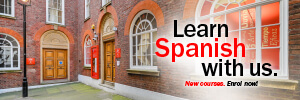Arte contemporáneo español en Londres 1: El arte sobre la mesa
Londres es una ciudad clave en materia de arte contemporáneo y atrae a un buen número de creadores españoles. El Instituto Cervantes Londres inicia una serie de actividades para dar más visibilidad a su trabajo, al tiempo que lo pone en relación con los artistas locales. Este programa presenta actividades con carácter trimestral, tomando como referencia un tema determinado. El primero de ellos explora las conexiones entre el arte, los alimentos y la gastronomía, a través de la ceremonia del banquete.
Comisaria: Marisa González
Artistas: Greta Alfaro, Lyne Collins, Marisa González, Natuka Honrubia y el colectivo anak&monoperro
Información sobre el evento: Exposición y mesa redonda el día 9 de Febrero a las 6.30pm en el Auditorio. La exposición, en diversos espacios del Instituto Cervantes londres, estará abierta al público hasta el 11 de marzo. En inglés y en español.
Art Workshop and Storytelling 2
Queridos todos:
Desde aquí queremos recordar vuestra participación en la actividad de Taller de Arte y Cuentacuentos que tuvo lugar el pasado sábado 13 de Noviembre en el Instituto Cervantes.
Asimismo, queremos agradecer por su actuación tanto a Lorena Carvajal como a Montse Domínguez que nos hicieron pasar una mañana de lo más divertida.
Por ello, aquí os dejamos un vídeo con una recopilación de los mejores momentos vividos el pasado sábado.
Muchas gracias por vuestra asistencia y esperamos que os hayáis divertido!
Art Workshop & Storytelling
 This activity includes The Art Trolley Workshop with Lorena Carbajal from 10.30 to 11.30am and Storytelling by Montse Domínguez from 11.30 am to 1.00 pm.
This activity includes The Art Trolley Workshop with Lorena Carbajal from 10.30 to 11.30am and Storytelling by Montse Domínguez from 11.30 am to 1.00 pm.
The Art Trolley Workshops provide a creative atmosphere where children can explore, create, express themselves, and learn through art, using a variety of exciting techniques from animation to printmaking.
Lorena Carbajal is an art espcialist educator and professional artist. She has worked as a puppeter, actress and storyteller.
Montse Domínguez has great experience with children. She has worked in the Westminster libraries as storyteller.
Venue:
Instituto Cervantes
102 Eaton Square. London. SW1W 9AN.
Saturday 13 November from 10.30am to 1.00pm.
See you there!!
Reclining male sculptures: The mesoamerican Chacmool
 ICLL Podcast series: New Episode (in English)
ICLL Podcast series: New Episode (in English)Lecture
One of the most distinctive types of Mesoamerican sculptures is that called Chacmool, representing reclining human figures holding vessels on the stomach. Chacmools have been found in Central and West Mexico as well as in the Maya region.
Elizabeth Baquedano has written several books and articles on the Aztecs, and curated an exhibition for Henry Moore’s Centenary at the University of East Anglia, Norwich. She is a lecturer at University College London, Institute of Archaeology and at the Institute for the Study of the Americas.
Moor to it than meets the eye

“THERE’s no fate worse than being blind in Granada,” a Spanish saying goes. But not all eyes can read what they see.
Granada’s incredible Alhambra, probably the most famous monument in all of Spain, has long been an object of fascination for historians, writers, artists and people in general.
Yet this beautiful palace-fortress still hides thousands of secrets, in particular the Arabic inscriptions that were written centuries ago. In fact, efforts to translate and interpret these inscriptions began almost as soon as the last Moors left Granada in 1492 after the Catholic monarchs completed the Reconquista of Spain.
Just nine years later, in 1501, a translation institute was established in Spain. Naturally, much of its work involved translating the Arabic left behind by centuries of Moorish rule.
Ever since, countless experts and visitors have been trying to decipher the meanings of the inscriptions which cover so many of the Alhambra’s walls, roofs, arches and other features. Foreign travellers, in particular the British artists of the 18th century, also attempted to study and catalogue the many thousands of verses and sayings.
Unfortunately, these works either failed to truthfully represent what was found, or covered only small parts of the Alhambra. In other cases, sadly, the work was lost.
The Silent Revolution
ICLL Podcast series: New Episode (in Spanish)
The Silent Revolution
 Graphic design between 1920 and 1950 constituted a means of distribution for aesthetic and political avant-garde ideas. In contrast with the Muralist movement, its presence was rather more modest but its scope was wider.
Graphic design between 1920 and 1950 constituted a means of distribution for aesthetic and political avant-garde ideas. In contrast with the Muralist movement, its presence was rather more modest but its scope was wider.
While the muralists were painting their masterpieces on official buildings, graphic art was being distributed through educational channels and channels for literacy campaigns all over the country. Some of the best artists participated in this work: Leopoldo Méndez, Alvarado Lang, Jean Charlot, Emilio Amero.
Small print production cooperatives such as Escuelas al Aire Libre, Taller de la Gráfica Popular (TGP) and artistic movements such as Los Estridentistas emerged.
Participants
José Manuel Springer
Collaborating Organisation
Embajada de México (Reino Unido)




